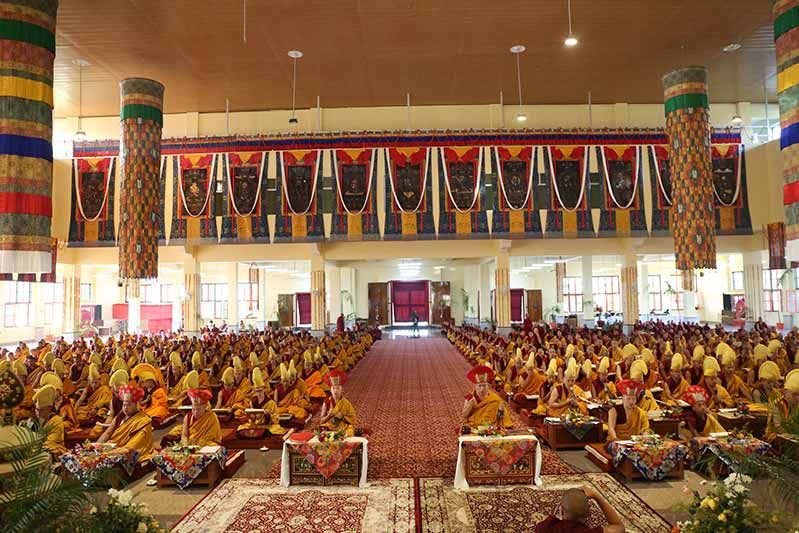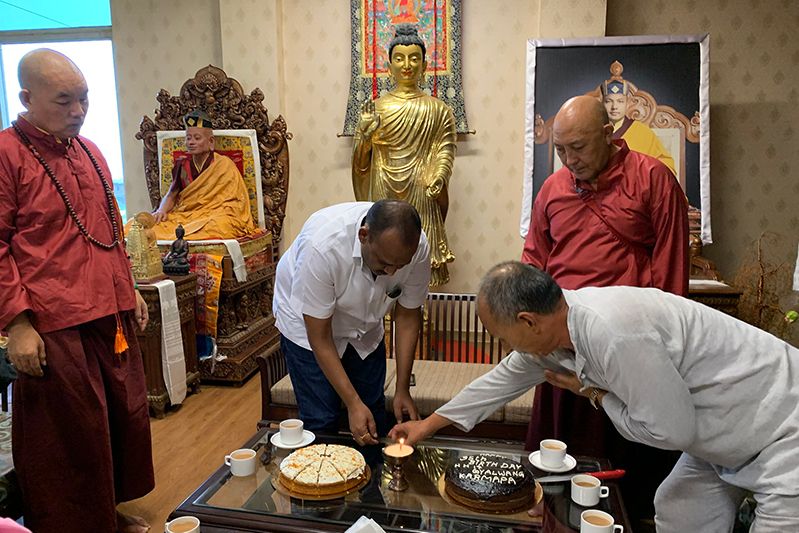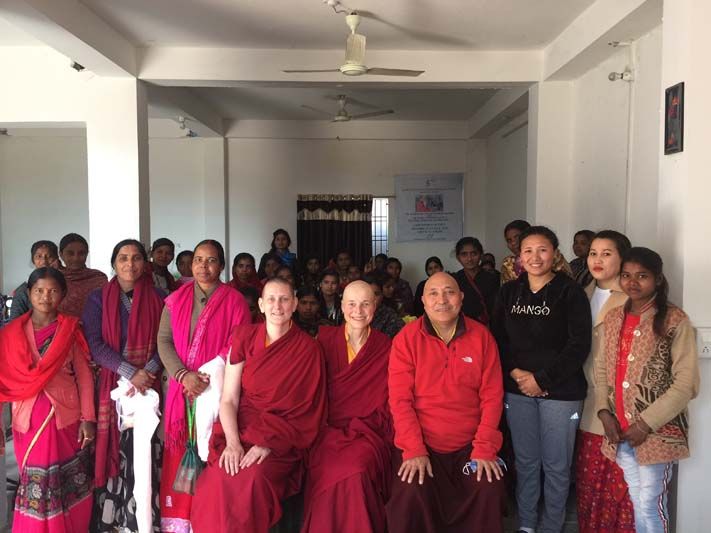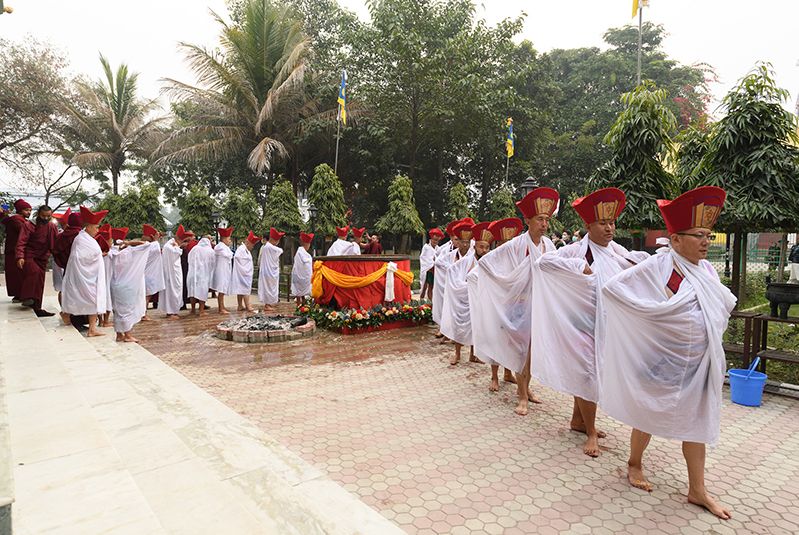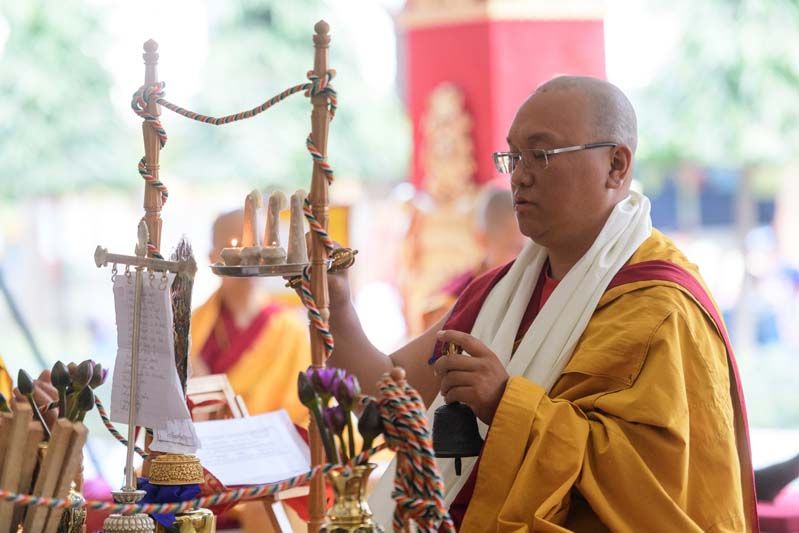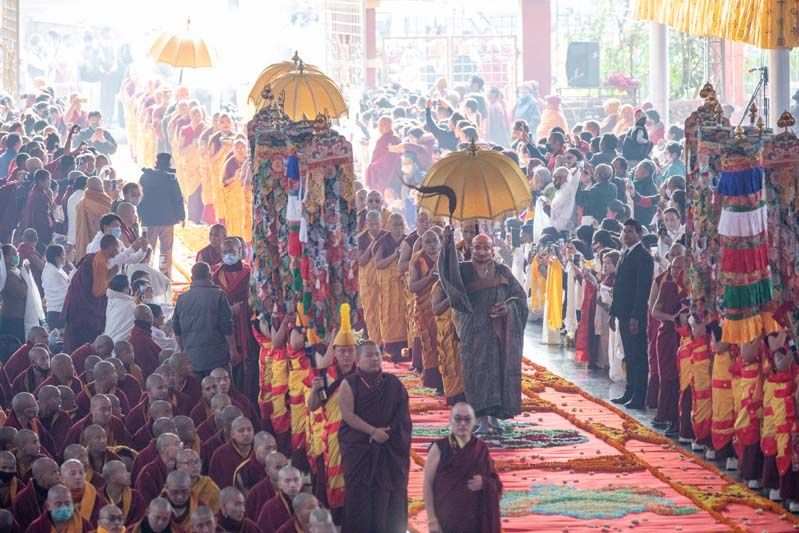New Codes of Discipline for Kagyu Monlam
- February 3, 2017
By His Holiness the 17th Gyalwang Karmapa
Date: 2004/07/28
Place: Gyuto, India
The reason why I invited the Uchos and representatives from 19 Kagyu monasteries of Nepal and India here is to express my thoughts on future planning of Kagyu Monlams.
Firstly about myself, I have spent my childhood like an ordinary child in my country. Later the Kagyupas gave me the grand name of Karmapa. My responsibility became quite heavy and my concern about Kagyupa flows naturally.
Frankly speaking, it will not be possible for me to compete with the kindness and the activities of previous Karmapas but timely change is important.
Coming to the point of talking on Kagyu Monlam, this is not an inovation after we reached India. This was initiated three hundred years back, by the 7th Karmapa Chodrak Gyatso, the 8th Karmapa Mikyo Dorje, the 9th Karmapa Wangchuk Dorje, and the 10th Karmapa Choying Dorje. During those days, although it was not called Kagyu Monlam specifically, but all Kagyupas gathered to appreciate the kindness of Gautama Buddha and to pray for peace in the world, just like today's Kagyu Monlam.
Similarly during the 7th Karmapa Chodrak Gyastso, the tradition of celebrating the four major festivals associated with the life of Buddha and especially celebrating the Chotrul Duechen, on the first month of the lunar calendar existed then.. During the festival, the precious relics of the garchen, yellow gold, dark gold and many other offerings never heard and seen in Tibet used to be displayed and changed daily. Karmapa Chodrak Gyatso would prostrate in front of the offerings.
In the mornings, he would himself recite the Great Aspiration prayer, which is one of the most important prayers today, with great respect. In the evenings the stories of the great masters of India and Tibet would be performed in wonderful song and dance drama.
Chotrul dawa coincides with Buddha’s festival and the Tibetan New Year. Normally, Karmapa Chodrak Gyatso did not grant long audiences to his faithful, but when tea is served to the Sangha the public was granted very short audiences. However during the relatively long morning prayer session the public would come just to have a glimpse of the Karmapa. According to the records the general public would come to watch the Garpa Losar performance of the year.
Since we have to try to follow the footsteps of our past masters as closely as possible, it is very important to understand and study the great deeds of these noble masters, and practice the true Dharma even in these degenerate times.
I myself have consistently studied the history and deeds of our past masters, and I hope that the Monlam ceremony should not just be good, but should be excellent in all respects.
Aspiration Prayer Rituals
Although there is nothing wrong in reading from the compilation of the Kagyu Monlam prayer book which is red in color, but there is also The 20 Chapter Aspiration Prayers composed by the 7th Karmapa Chodrak Gyatso. During the great masters’s time, this prayer used to be read during the Gar-Ki Chotrul Monlam.
I have received such a prayer book, and it is a very good one. It is Sutra rituals which are the teachings of the Buddha. There are also other compilation of prayers of each particular lineage of Buddhism which therefore often cause inconvenience to many who attend the Monlam from other lineages, such as Sakya, Nyingma and Geluk.
Since Buddha’s teachings are universally respected and beyond any doubts, I feel that it would be most suitable if we can recite these prayers as compiled by Karmapa
Chodrak Gyatso . I am presently compiling and editing this prayer book.
The 20 Chapter Aspiration Prayers was first recited during the Lhabab Duechen which is on the 15th day of the 9 th month. Thereafter, whenever there is a major Buddhist festival these prayers are chanted with sincere aspiration vows, and as recorded in the Chojung Khe-pai and Kamtsang Chojung texts, miraculous incidents would occur, such as the appearance of rainbows, the raining of flowers, in Kongpo district where eagles are rarely seen, many eagles are seen circling the skies, the ground covered with fresh flowers, and fragrant rain.
Therefore, we will base our prayers on this compilation. It is also necessary to add some supplements, such as the popular prayers composed by ancient Indian masters in praise of Buddha, Kyebar Phagto, Lha le phuljung, Ngag wo ngag to, and Topa Gya Nga chupa. I think it will be very good if we recite these prayers.
Normally when we recite the long life prayers, we only recite Kamtsang prayers, which is necessary. Earlier this was known as Kamtsang Monlam but now it is called Kagyu Monlam, a very grand name. So the prayer compilation has to match the grand name. Otherwise the name and the fact may not match.
We started this Kagyu Monlam for the development of Buddha dharma in general and Kagyu teachings in particular. We should also recite the prayer for long life of the great masters of Drikung Kagyu, Drukpa Kagyu and Taklung Kagyu. Otherwise it will be biased, and will harm the unity of Kagyu. Similarly since Rumtek and Sherabling are the two major monasteries of Kamtsang, the chant masters of these two monasteries should lead the daily prayers alternately. Since the recitation of the prayers this time is slightly different from before, I will explain them in detail later on.
Prayer Ceremony Rules of Conduct
As we all are followers of Buddha so we must follow the three advices of Buddha. If one is an ordained monk, he must obey the precepts of the Rabjung. If one is a Buddhist layman he must obey the precepts the Ge-nyen. Although both Gelong and Ge-tsul monks attend the Kagyu Monlam, yet many of them lack some of their required possessions.
For example some Gelongs don't have Namjar, some don't have Thango and Lhungsey. Many things are lacking. According to the ancient by laws of Kagyu monastery, all Gelong must have the three possessions: the three dharma robes, a begging bowl and a sitting mat. It was compulsory to have them.
According to regulations in the Karma Shungluk Ling, laid down by the 8th Karmapa Mikyo Dorje it was stressed that in this institution of monks the three robes, sitting mat and bowl are absolute requirements. Therefore, in our Kagyu Monlam, even if we could not provide for the all Getsuls, but at least we must provide for all the Gelongs as soon as possible. The crescent-shaped cape is also necessary because mornings and evenings in Bodhgaya is cold. Wearing a coat or wrapping the shawl (gsan) on the head is not correct so the crescent-shaped cape is both comfortable and acceptable by rule.
The three dharma robes are skirt(thango), shawl (lago, chogo), and shawl(namjar). Since these are important, I have given a small amount offering to the representatives of the monasteries to provide the required robes for the monks. Actually an under-garment beneath the present skirt is necessary, so we thought a lighter under-garment would be better. The color also must be the three permissible ones. I will give a sample of the colors tomorrow.
The proper way of wearing the three dharma robes must be according to the prescribed rules. According to Karmapa Mikyo Dorje, the three dharma robes should be worn around from the top of the shoulders and should not cover the face or twisted in a casual manner. Especially the under-garment and skirt should reach up to the ankles and not any longer than that. The vest (tongaks) must be neatly tucked under the belt.
Vinaya rules also prescribed blessing for the possessions. Therefore, the fully ordained monks must have their robes (Namjar) duly blessed.
I hope that during the Kagyu Monlam, all fully ordained monks will take the Mahayana vows (Bodhisattva's vow) every morning. Those Getsuls and laypersons, who wish to take vows may also do so and abstain from taking evening meals.
On the first day of sojong, four senior fully ordained monks from this congregation will deliver the Mahayana vows and bless the possessions.
While attending the assembly, the fully ordained monks will wear the skirt (thangsham) and under-garment (thangsham san), wrap the dharma robe(lago, chogo), and the shawl (nulsan) around the shoulders, drape the shawl(namjar) on the shoulder, wear the crescent-shaped cape (dhakham) on the back, yellow hat and begging bowl in hands, prostrate three times and proceed to their seats in an orderly way.
When the master lama is seated the hats must be held in the hands to show respect, and put on the right side when seated.
While coming to attend the teachings, one need only drape the shawl(namjar) on the shoulders and the dharma robe(lago, chogo) wrapped around the shoulders, but there is no need to carry the bowl, the hat and the crescent-shaped cape (dhakham).
According to tantra, it says that during the assembly and teaching if some one has to leave the room they must prostrate three times before leaving as a form of seeking permission and three times before sitting down as a form of apologizing.
The multi-color hat that we wear used to be called meditation hat and perhaps only great mediators(sgom-chens), used to wear them. Karmapa Mikyo Dorje said, in the rules for monasteries, that the yellow hat(tse sha) must be worn, and that in most large monasteries it was the custom to wear this hat.
The seating posture in the assembly, as laid down in some ancient rule texts, must be in accordance with the Sevenfold posture of Vairochana(Nam nang Choe dun) which is not easy. Therefore, a similar style such as legs crossed in vajra asana, hands in meditation posture(chag nyam shag), and backbones straight like an arrow, chin slightly bent down, eyes focused on the tip of nose, and meditate and recite prayers without diverting the mind from compassion and Mahamudra.
Even if this is not achievable, while reciting prayers, at least we should refrain from talking or looking around casually. Otherwise such recitations are neither prayer nor meditation and one is only fooling oneself and others. This rule for prayer is not only for fully ordained monks but also applicable to novices and layperson.
Moreover, one must sit in the assembly in an orderly manner.. Rows must be uniform and enough spaces left in between for tea servers and disciplinarians to walk around. The seating order must be according to Vinaya rules duly respecting seniority.
The fully ordained monks must, before taking tea and offerings recite with folded hands the mantras for purification of the offerings, namo baghawati sumeru kalpa rajya tathagataya aryate samnyag sambudhaya, tyatha om kalpe kalpe maha kalpe kalpepari shodhani swaha. After reciting they must with respect and folded hands receive the offering. Fully ordained monks must recite these mantras by heart and recite to purify offerings.
Seats
Thirdly talking about seats, during the Kagyu Monlam, which used to be held at the time of Karmapa Chodrak Gyatso, who always preferred to sit on a mat and not on the throne. Therefore, when we come here and pray at the great site of Buddhism, in Bodhgaya and, in front of the great stupa of Buddha, it is not proper to sit on a high throne. Hence, in keeping with the deeds of the former Kagyu masters all of us will sit on a low mat. However, during the teaching, a throne is allowed to highlight the teacher and to show respect for his great teachings.
It is possible that some people may argue that the teachings of Kagyu must flourish and therefore, sitting without a throne is not proper. We have seen that earlier when our Kagyu lineage was at its peak, great masters preferred low seats. Therefore, this will be in accordance with the great deeds of the ancient masters of abandoning greed and pride. To follow this path will definitely help spread and glorify the Kagyu teachings and not harm it. We should have no doubts about this.
Similarly the disciplinarians(ge kos), of the monasteries have a heavy responsibility. If they sit at one place then they will not be able to see the situations in other parts of the room. Therefore they must walk around the assembly.
To begin with, the disciplinarians and their assistants must check the list of the monks and see that they are all present at the assembly. Otherwise many monks are absent from the assembly and wander around in markets. They must concentrate on the discipline at the assembly. If somebody violates the rules then they must be advised and not punished immediately. It is not proper to admonish the monks in public places.
Also these days many monks wear fancy shoes, which look odd, and not a good example. We must, therefore, also wear proper simple shoes. All the monks must shave their heads frequently.
Conclusion
To conclude, please bear in mind seriously what I have said above. I also consider all previous Karmapas as my masters and I have never in my life been arrogant of the fact that I am the Karmapa. My responsibility is to contribute to the great deeds of the past masters and to preserve, protect and promote the pure teachings of the past masters during this degenerate time. This is not only my responsibility but everyone else’s as well.
Therefore, you must all strive hard with pure motivation for the development of the Kagyu lineage. Especially during the Monlam, as a Bhikshu, your every thought and conduct must be in accordance with that of Buddha’s aspirations, and they must not even for a moment be delayed or postponed. We must not sit back and blame the degenerate times but must be courageous enough to face it.
All of us Kagyupas must take up the cause of the Kagyu lineage as a personal responsibility and must strive hard for the advancement of the Dharma.
It is not right to hold the narrow opinion that your Kagyu is the true Kagyu and others as non-Kagyu; then you are abandoning the Dharma, a disgrace to the Kagyu and not an honor to the lineage.
Generally speaking all the lineages of Tibetan Buddhism are interconnected with each other and have their roots in Vajradhara. To provoke differences among each other will weaken the samaya bonds between them.
In the future, I have great confidence that all the other masters of Kagyu will join us in the coming Monlam. Perhaps some of you may consider my view as childish. I am an ordinary being and therefore, doubtful whether all my activities are true to the dharma. But I have with the best of intentions and will do my utmost for the Dharma.
I hope this will not displease some of the masters, and hope that this will set a good example for all the future devotees of Kagyupa. Thank you.
-----------------------------------------------------------------------------------------------------------------------------------------------------------
Translated from the Chinese text (a direct translation from the Tibetan text) by the translation group of Hwa Yue Foundation, Taipei, Taiwan, November 2005. With grateful reference to the English translation by Jamyang Dorje for Dharma Nectar, January 2004.

37th Kagyu Monlam Schedule
Tibetan / English / Chinese • French • German • Indonesian • Korean • Polish • Russian • Spanish • Vietnamese
Dharma Teachings
 Meditation Instructions
Meditation Instructions
Recorded during the 37th Kagyu Monlam, Bodhgaya, India. January 28-30, 2020.
